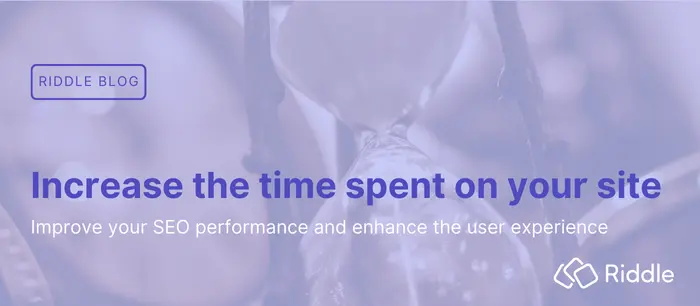Search engines like Google or Bing will always provide users with links to the most relevant and valuable content first. The search engine determines the informational value of the content by measuring whether the user remains on the clicked link or returns directly to the search results. A user’s decision to stay on a site indicates that the result was useful.
The measurement to figure out if the content was useful is called time on site (or sometimes time on page). Suppose the user returns to the search results after a few seconds? In that case, the search engine will conclude that the result did not align with the user’s initial search query and may display that page with reduced frequency or at a lower position in the search results.
Engaging your audience and encouraging them to spend more time on your website is essential for improving your SEO rankings. The longer visitors stay on your site, the more opportunities they have to explore your content, interact with your brand, and convert into valuable leads or customers.
We will explore proven strategies and techniques to captivate your audience and make your website a must-visit destination. Slight spoiler alert: You’re reading this post on Riddle’s blog so we’ll be sharing how our quiz maker makes it easy to create ‘sticky’ / high time on site content like quizzes and personality tests.
So, whether you are an e-commerce site, a news outlet, or a service provider, increasing time on site is vital to your success. Get ready to uncover the secrets that will transform your website and maximize your SEO potential. Let’s dive in and take your website engagement to new heights!
Take this quiz to test your basic SEO knowledge
What is time on site?
Time on site, also referred to as average session duration or average time on page, is a metric that gauges the duration of a user’s engagement with a website or a specific page within that website. This is calculated by dividing the total time spent on the website or page by the number of sessions or page views.
This metric offers valuable insights into the level of engagement and interest demonstrated by visitors to your content and website. A high time on site indicates that users are engaging with your content, navigating your website easily, and spending significant time exploring your offerings. On the flip side, a low time on site may indicate that users quickly leave your website, need help finding the information they are seeking, or are uninterested in the content you are presenting.
Time on site can vary depending on the type of website and the user’s intent. For instance, a news or media website may have a higher average time on site due to users engaging with long-form articles and videos. In contrast, an e-commerce site may have a lower average time on site as users quickly navigate to find and purchase the products they need.
Understanding the typical time on site for your industry and comparing your website’s performance to industry benchmarks can help you identify areas for improvement and set realistic goals for increasing engagement.
In 2025, dwell time is still highly important for organic search – one study showed that getting a 20% lift in time on site resulted in a 5% across the board ranking boost. Doubling dwell time more than tripled that – with an 18% lift.
The importance of increasing time on site
In the digital age, where attention spans are dwindling and competition for user engagement is fierce, visitors’ time on your website has become a critical metric for success. Increasing time on site is more than just retaining users on your platform for an extended period.
It is a core strategy for enhancing engagement, optimizing search engine results, and ultimately driving increased conversions and revenue for your business. The longer a user remains on your website, the greater the opportunity to engage them, showcase your products or services, and nurture them through the sales funnel.
Users spending more time on your site are more likely to explore multiple pages, engage with your content, and develop a stronger connection with your brand. This increased engagement can result in higher conversion rates, as users who are invested in your content are more likely to take desired actions, such as making a purchase, signing up for a newsletter, or filling out a contact form.
Moreover, time on site is a significant factor in search engine algorithms. Google and other major search engines utilize dwell time, defined as the amount of time a user spends on a page after clicking on a search result, as a signal of the relevance and quality of your content. The more time users spend on your pages, the more search engines will recognize your website as a valuable and authoritative resource, which can lead to higher search engine rankings and increased organic traffic. By optimizing for increased time on site, you can enhance the user experience and improve your overall SEO performance, driving more qualified leads and potential customers to your business.
What strategies can be employed to increase time on site?
The most effective way to increase time on site is to provide users with the exact content they are searching for. If you can achieve this consistently, you will eventually achieve a top-three position in Google. However, providing the optimal content to every user immediately is challenging, particularly given the limited attention span of the typical internet user. The two most effective methods for retaining readers on your site are:
- Displaying a brief video.
- Inviting engagement through a challenge, such as a quiz, poll, or personality test.
Video content is highly effective. Readers already spend considerable time scrolling through social media platforms such as TikTok or Instagram and are used to consuming short videos. However, creating a video requires high expertise and time investment. An unprofessional video will have a detrimental impact on your time on site.
Quizzes are an excellent way to engage readers. They have been used to entertain readers for decades, long before the advent of the internet. If you are old enough to remember paper magazines, you may recall the many quizzes or personality tests they had at the end of each issue. Readers would calculate their results by counting how often they selected answers a), b), or c). Creating a quiz in minutes is now also possible using Riddle.com’s A.I. tools.
Create a quiz that fits the topic of your page content and make it 5 to 8 questions long. The questions should not be too complicated or frustrate users but still challenging enough to keep them reading and answering.
Quizzes increase time on site by 3 minutes
We have conducted studies and interviewed our customers about how a quiz affects the time spent on a web page. The BBC tells us that adding a quiz to an article increases the time on site to 3 minutes and 45 seconds. The average time a reader spends on any web page across the internet is 54 seconds, according to a study cited by Hubspot.
Based on our data the time on site increase by adding a quiz is from 0:54 to 3:56 minutes – a 421% increase. You can find our sources for these numbers in our annual quiz marketing report.
If you cannot find the time or suitable topics for a quiz, you can also add a quick poll to every page. While polls do not increase time on site as much as quizzes or personality tests, they will get people to interact and also take a few seconds to study how other people have voted in the poll.
You can also find inspiration in our guide ‘143 proven quiz titles your audience will love’ – full of excellent tips and best practices around crafting compelling titles that work.
Monitoring and improving time on site
To ensure your website is performing optimally, it is crucial to have a comprehensive system in place to measure and track time on site. It is advisable to employ web analytics tools, such as Google Analytics, to collect and analyze data about user engagement and behavior on your website.
Monitor key performance indicators related to time on site, including average session duration, pages per session, and bounce rate. These metrics should be analyzed across different pages, content types, and user segments to identify areas of strength and opportunities for improvement.
For instance, you may discover that specific blog posts or product pages have considerably longer average time on site than others, which can provide valuable insights into the content and features that resonate most with your audience.
Furthermore, establish benchmarks and objectives for enhancing time on site and consistently assess your progress. This will assist you in evaluating the efficacy of your engagement-boosting strategies and making well-informed decisions about future website optimizations.
But remember… improving time on site is a continuous project.
Continuously refine your approach based on the data and insights you gather. By being prepared to test and iterate, you can identify the most effective ways to increase time on site and drive superior overall website performance.
Further reading
Definition of time on site and why it is essential to measure and improve it by AgencyAnalytics
Industry benchmarks for average time on page by MetricHQ
Frequently Asked Questions (FAQ)
Why is time on site important for SEO performance?
Time on site helps search engines determine if your content meets user expectations. If visitors leave quickly, it signals low relevance; if they stay, it shows satisfaction and usefulness. Longer sessions can lead to better search visibility and user retention. Riddle’s interactive tools encourage visitors to spend more time exploring your site, improving both engagement and SEO results.
How can I increase time on site effectively?
You can increase time on site by publishing content that is informative, easy to read, and visually appealing. Use videos, images, and internal links to keep users exploring your site. Interactive elements are especially effective—Riddle allows you to embed quizzes, polls, and personality tests that turn passive visitors into active participants and extend their stay.
Does time on site affect Google rankings directly?
Google does not officially confirm time on site as a ranking factor, but it indirectly influences SEO by signaling engagement and reducing bounce rates. Pages that keep users longer tend to rank higher because they satisfy search intent more effectively. Riddle’s interactive experiences can help achieve this by increasing visitor engagement and dwell time.
What type of content increases time on site the most?
Interactive and engaging content keeps visitors on your site longer. Quizzes, polls, infographics, and long-form guides are among the most effective formats. When visitors actively participate, they spend more time and explore further. Riddle makes it simple to create these types of interactive experiences, helping you significantly boost your website’s average time on site.
What is considered a good average time on site?
Ideal time on site varies by industry. For example, news and blog websites may average two to four minutes, while e-commerce sites often see shorter sessions due to faster purchasing behavior. The key is to measure and improve your own baseline. Many Riddle users report increasing their average time on site by over 400 percent after adding interactive quizzes or polls.



